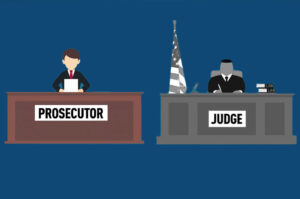What is Appellate Court?
An appellate court, also called an appeals court or court of appeals, is a court that hears appeals from lower courts. Appellate courts do not conduct trials or hear evidence. Instead, they review decisions of lower courts to determine if any legal errors occurred.
Appellate courts exist at both the state and federal court levels. They are typically composed of a panel of three judges who review the proceedings and decisions of the lower courts. The judges will examine the lower court’s application of the law and procedure. Then, the appellate court will either affirm the lower court’s judgment, reverse it completely, or sometimes order a new trial.
The Hierarchy of the Judiciary
Before delving deeper into appellate courts, it’s essential to understand their place within the judicial hierarchy. In most legal systems, the hierarchy begins with trial courts, followed by appellate courts, and ultimately, the highest court in the land, often referred to as the Supreme Court.
Purpose of Appellate Court
There are a few key purposes of having appellate courts within the judicial system:
- Error correction – Appellate courts serve as a “check” on lower courts to ensure the law was applied correctly and procedures were properly followed. If errors occurred, the appellate court can fix the mistakes.
- Consistency – Appellate courts establish binding precedents with their decisions. This provides consistency in how laws are interpreted and applied within their jurisdiction.
- Developing legal standards – Appellate court decisions help develop legal rules and standards used in future cases. Precedents set by appellate opinions guide lower courts’ rulings.
Structure of Appellate Court
Appellate courts are structured differently than trial courts:
- No jury – Only judges review the appeal and make a ruling.
- 3+ judges – Appellate cases are heard by a panel of at least three judges in most courts.
- No witnesses or new evidence – The focus is reviewing the official record from the lower court.
- Hear oral arguments – Lawyers for each side present arguments to the judges.
This structure allows appellate judges to closely analyze the proceedings and ruling of the lower court. Multiple judges help balance perspectives when deciding complex legal issues.
Types of Appellate Courts
There are two main types of appellate courts in the United States judicial system – state appellate courts and federal appellate courts.
State Appellate Courts
Every state has an appellate court system that provides appeals for criminal and civil matters in state courts. These are usually called the “[Name of State] Court of Appeals” or “[Name of State] Supreme Court.” Some key things to know:
- Highest state court – A state supreme court is the highest appellate court at the state level. Its decisions are binding across the state courts.
- Intermediate appellate courts – Many states have intermediate appellate courts that hear appeals from lower courts before going to the supreme court.
- Specialized courts – Some states have appellate courts that specialize in certain types of cases, like business disputes.
Federal Appellate Courts
The federal court system contains appellate courts that review federal trial court rulings. There are two main federal appellate courts:
U.S. Courts of Appeals
- 13 circuits organized regionally across the U.S.
- Hear appeals from federal district courts within their circuit
- Binding precedent for district courts in their jurisdiction
U.S. Court of Appeals for the Federal Circuit
- Specialized appeals court based in DC
- Hears specialized cases like patent and trade cases
- Binding precedent across the nation in certain subject areas
So in summary, federal appellate courts focus on reviewing federal trial court cases, while state appellate courts handle state court appeals. Both play an important role.
Appellate Court Process
If a party in a case wants to appeal a trial court’s decision, there is a detailed process that takes place in appellate courts:
Filing an Appeal
- Notice of appeal – This gives the court and other party notice of the intent to appeal within a set time period after the judgment. This is usually 30 days.
- Record of lower court – The clerk of court prepares the full record from the lower court proceedings and sends it to the appellate court.
Briefs
- Appellant brief – The appellant (party initiating the appeal) files a written legal brief detailing why the lower court erred and why the decision should be reversed or modified.
- Appellee brief – The appellee (opposing party) files a response brief defending the lower court’s decision and why it should be upheld.
- Reply brief (optional) – The appellant can choose to file another brief countering the appellee’s arguments.
Oral Arguments
- Lawyers present oral arguments summarizing their positions to the panel of appellate judges. Each side typically gets 15-30 minutes. The judges will often interrupt and ask questions.
- Oral arguments allow the judges to directly query the lawyers on their legal reasoning before making a decision.
The Court’s Decision
After oral arguments, the appellate judges privately confer and make their decision, which will typically take one of three actions:
- Affirm the lower court’s decision, meaning they agree with the ruling.
- Reverse the lower court’s decision, determining it was incorrect.
- Vacate (set aside) the lower court’s decision and order further proceedings or a new trial.
The appellate court will issue a written opinion explaining their legal reasoning for the decision. Opinions from appeals courts serve as important legal precedents.
Role of Appellate Judges
Appellate court judges have different responsibilities than trial court judges:
Reviewing Lower Court Decisions
- Appellate judges focus on analyzing the application of the law and procedures of the lower court. They examine the record of proceedings and may quiz lawyers during oral arguments.
- They do not determine credibility of witnesses or find facts. Those roles stayed with the lower court.
Establishing Precedent
- Appellate rulings establish binding precedent within their jurisdictions. This precedent must be followed by lower courts going forward.
- By issuing written opinions, appellate judges can develop legal rules and standards. This provides guidance for judges in future cases.
So in summary, appellate judges serve as reviewers and lawmakers rather than fact finders. Their rulings shape legal standards.
Pros and Cons of Appellate Courts
There are advantages and disadvantages to having appellate courts:
Pros
- Corrects legal errors – Appellate review is the primary way to identify and fix mistakes in applying the law.
- Provides consistency – Having binding precedent leads to more uniform rulings on the same types of cases.
- Develops legal guidance – Appellate opinions establish new interpretations of the law when needed and clear up confusion.
Cons
- Delayed finality – Appeals prolong the legal process. It can take months or years before a binding decision.
- Added costs – The appeal itself as well as delays add expenses for courts and parties.
- Inconsistency – Differing appellate rulings may emerge on the same issue, leading to splits of authority.
So in an ideal system, appellate courts increase fairness through error correction and consistency. But the tradeoff can be added time and uncertainty.
Famous U.S. Appellate Court Cases
Some landmark cases that were decided at the appellate level include:
Brown v. Board of Education (1954)
- This U.S. Supreme Court ruling overturned Plessy v. Ferguson and declared racial segregation in public schools as unconstitutional.
- It helped ignite the civil rights movement and the push toward desegregation.
Roe v. Wade (1973)
- The Supreme Court established through this case a constitutional right to privacy that protected a woman’s choice to have an abortion.
- The ruling was extremely contentious and abortion rights continue to be debated today.
Miranda v. Arizona (1966)
- This famous Supreme Court case required police to inform suspects in custody of their constitutional rights prior to interrogation. This became known as Miranda rights.
- It had a major impact on arrest and interrogation procedures for police.
Conclusion
In conclusion, appellate courts play a unique and important role in the United States judicial system. Their primary purpose is to review lower court decisions for legal errors, help ensure consistency in rulings, and establish precedents that guide future cases. Having multiple levels of appellate courts and specialized judges enables a robust appeals process. While not perfect, appellate courts have a critical responsibility in shaping many aspects of the law.
FAQs
How many judges typically hear an appellate case?
Most appellate cases are heard by a panel of three judges in both state and federal appellate courts. Some courts may have larger panels for certain cases.
Can new evidence be introduced during an appeal?
Generally no. Appellate courts only review the official record from the lower court proceedings. No new evidence, witnesses, or testimony are allowed during the appeal.
Can an appellate court change a jury’s decision?
An appellate court cannot override or change a factual finding made by a jury. But it can determine the lower court made an error in applying the law and overturn or modify the legal conclusions.
What happens in state supreme courts?
A state supreme court is the highest appellate court at the state level. It typically reviews decisions from the intermediate appellate courts. Their decisions are binding across the state.
How long do appellate judges serve?
Federal appellate judges have lifetime appointments. State appellate judges may be appointed or elected, and serve terms that vary by state – ranging from 4 years to lifetime. Most serve 8-12 year terms.





